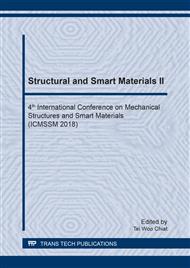[1]
X. Zhao, B. Guo, H. Wu, Y. Liang, P.X. Ma, Injectable antibacterial conductive nanocomposite cryogels with rapid shape recovery for noncompressible hemorrhage and wound healing, Nat. Commun. 9(2018) 2784.
DOI: 10.1038/s41467-018-04998-9
Google Scholar
[2]
R. Gu, W. Sun, H. Zhou, Z. Wu, Z. Meng, X. Zhu, Q. Tang, J. Dong, G. Dou, The performance of a fly-larva shell-derived chitosan sponge as an absorbable surgical hemostatic agent, Biomaterials 31(2010) 1270-1277.
DOI: 10.1016/j.biomaterials.2009.10.023
Google Scholar
[3]
A. Muxika, A. Etxabide, J. Uranga, P. Guerrero, K. de la Caba, Chitosan as a bioactive polymer: processing, properties and applications, Int. J. Biol. Macromol. 105(2017) 1358-1368.
DOI: 10.1016/j.ijbiomac.2017.07.087
Google Scholar
[4]
I. Hamed, F. Özogul, J.M. Regenstein, Industrial applications of crustacean by-products (chitin, chitosan, and chitooligosaccharides): A review, Trends Food Sci. Technol. 48(2016) 40-50.
DOI: 10.1016/j.tifs.2015.11.007
Google Scholar
[5]
J. Benesch, P. Tengvall, Blood protein adsorption onto chitosan, Biomaterials 23(2002) 2561-2568.
DOI: 10.1016/s0142-9612(01)00391-x
Google Scholar
[6]
Z. Hu, D.Y. Zhang, S.T. Lu, P.W. Li, S.D. Li, Chitosan-based composite materials for prospective hemostatic applications, Mar. Drugs 16(2018) 273.
DOI: 10.3390/md16080273
Google Scholar
[7]
S.F. Antonov, E.V. Kryzhanovskaya, Y.I. Filippov, S.M. Shinkarev, M.A. Frolova, Study of wound-healing properties of chitosan, Russ. Agr. Sci. 34(2008) 426-427.
DOI: 10.3103/s1068367408060190
Google Scholar
[8]
S. Saladino, E.R. Di Leonardo, M. Salamone, D. Mercuri, F. Segatti, G. Ghersi, Formulation of different chitosan hydrogels for cartilage tissue repair, Chem. Eng. Trans. 38(2014) 505-510.
Google Scholar
[9]
R. Logithkumar, A. Keshavnarayan, S. Dhivya, A. Chawla, S. Saravanan, N. Selvamurugan, A review of chitosan and its derivatives in bone tissue engineering, Carbohydr. Polym. 151(2016) 172-188.
DOI: 10.1016/j.carbpol.2016.05.049
Google Scholar
[10]
L. Xing, Y.T. Fan T.J. Zhou J.H. Gong L.H. Cui, K.H. Cho, Y.J. Choi, H.L. Jiang, C.S. Cho, Chemical modification of chitosan for efficient vaccine delivery, Molecules 23 (2018) 229.
DOI: 10.3390/molecules23020229
Google Scholar
[11]
Q. Yuan, J. Shah, S. Hein, R.D.K. Misra, Controlled and extended drug release behavior of chitosan-based nanoparticle carrier, Acta Biomater. 6(2010) 1140-1148.
DOI: 10.1016/j.actbio.2009.08.027
Google Scholar
[12]
A. Lagarto, N. Merino, O. Valdes, J. Dominguez, E. Spencer, N. de la Paz, G. Aparicio, Safety evaluation of chitosan and chitosan acid salts from Panurilus argus lobster, Int. J. Biol. Macromol. 72 (2015) 1343-1350.
DOI: 10.1016/j.ijbiomac.2014.10.030
Google Scholar
[13]
C.R. Mohan, R. Sathya, P. Nithiananthi, K. Jayakumar, Ultrasonic velocimetry studies on different salts of chitosan: effect of ion size, Int. J. Biol. Macromol. 104 (2017) 1596-1603.
DOI: 10.1016/j.ijbiomac.2017.02.049
Google Scholar
[14]
Y. Murata, K. Nagaki, K. Kofuji, T. Kishi, Functions of chitosan-ferulic acid salt for prevention of hypertension, Food Sci. Technol. Res., 16 (2010) 437-442.
DOI: 10.3136/fstr.16.437
Google Scholar
[15]
P.L. McCormack, Tranexamic acid: a review of its use in the treatment of hyperfibrinolysis, Drugs 72(2012) 585-617.
DOI: 10.2165/11209070-000000000-00000
Google Scholar
[16]
P. Zhang, J. He, Y. Fang, P. Chen, Y. Liang, J. Wang, Efficacy and safety of intravenous tranexamic acid administration in patients undergoing hip fracture surgery for hemostasis: A meta-analysis, Medicine 96(2017) e6940.
DOI: 10.1097/md.0000000000006940
Google Scholar
[17]
Z. Hu, P. Hong, M. Liao, S. Kong, N. Huang, C. Ou, S. Li, Preparation and characterization of chitosan-agarose composite films, Materials, 9 (2016) 816.
DOI: 10.3390/ma9100816
Google Scholar
[18]
S.S. Bhattacharya, S. Banerjee, P. Chowdhury, A. Ghosh, R.R. Hegde, R. Mondal, Tranexamic acid loaded gellan gum-based polymeric microbeads for controlled release: in vitro and in vivo assessment. Colloids Surf. B 112(2013) 483-491.
DOI: 10.1016/j.colsurfb.2013.07.054
Google Scholar


